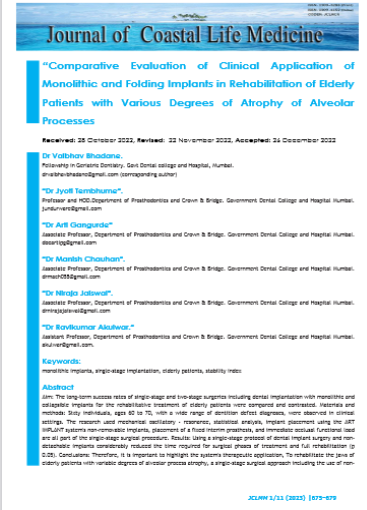“Comparative Evaluation of Clinical Application of Monolithic and Folding Implants in Rehabilitation of Elderly Patients with Various Degrees of Atrophy of Alveolar Processes
Main Article Content
Abstract
Aim: The long-term success rates of single-stage and two-stage surgeries including dental implantation with monolithic and collapsible implants for the rehabilitative treatment of elderly patients were compared and contrasted. Materials and methods: Sixty individuals, ages 60 to 70, with a wide range of dentition defect diagnoses, were observed in clinical settings. The research used mechanical oscillatory - resonance, statistical analysis, implant placement using the ART IMPLANT system's non-removable implants, placement of a fixed interim prosthesis, and immediate occlusal functional load are all part of the single-stage surgical procedure. Results: Using a single-stage protocol of dental implant surgery and non-detachable implants considerably reduced the time required for surgical phases of treatment and full rehabilitation (p 0.05). Conclusions: Therefore, it is important to highlight the system's therapeutic application, To rehabilitate the jaws of elderly patients with variable degrees of alveolar process atrophy, a single-stage surgical approach including the use of non-detachable (monolithic) dental implants has been developed.
Article Details
References
“Kandelman D., Petersen P.E., Arpin S., Ogawa H. Global oral health of older people – call for public health action. Community Dental Health. 2010; 27 (2): 257-268. 2.
Compton Sh.M., Clark D., Chan S. et al. Dental Implants in the Elderly Population: A Long-Term Follow-up. Int J Oral Maxillofac Implants. 2017;32(1):164-170.
Manfredini, D., Poggio, C.E. & Lobbezoo, F. (2014) Is Bruxism a risk factor for dental implants? A systematic review of the literature. Clinical Implant Dentistry and Related Research 16: 460–469.
Cardaropoli, G., Lekholm, U. & Wennstrom, J.L. (2006) Tissue alterations at implant-supported single-tooth replacements: a 1-year prospective clinical study. Clinical Oral Implants Research 17: 165–171.
Gheisari R., Eatemadi H., Alavian A. Comparison of the Marginal Bone Loss in One-stage versus Two-stage Implant Surgery. J Dent (Shiraz). 2017; 18(4): 272–276.
Schrott A., Riggi-Heiniger M., Maruo K., Gallucci G.O. Implant loading protocols for partially edentulous patients with extended edentulous sites--a systematic review and metaanalysis. Int J Oral Maxillofac Implants. 2014; 29: 239-255.
Thoma D.S. et al. Efficacy of lateral bone augmentation performed simultaneously with dental implant placement: a systematic review and meta-analysis. J Clin Periodontol. 2019;46(21):257.
Herrero-Climent M., Ruiz R.M.M., Diaz-Castro C.M. et al. Influence of two different machined-collar heights on crestal bone loss. Int. J. Oral Maxillofac. Implants. 2014;29: 1374–1379.
Yaremenko O.I., Kotenko M.V., Rozdors'kyy V.V., Snizhko V.V. Porivnyal'nyy analiz efektyvnosti metodiv nehaynoyi implantatsiyi (Chastyna II). Instytut stomatolohiyi. 2013;4(58):36-37.

